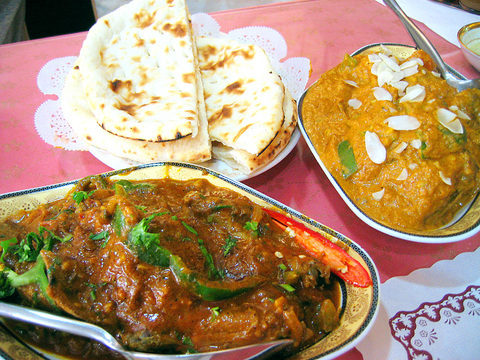Over the past couple of years the number of South Asian eateries in Taipei has climbed to an all-time high. Sadly, however, the increase in numbers doesn't mean that good Indian or Pakistan fare is readily available. Some of the joints might boast "the real thing" in their adverts, but the reality is often different.
All too often, regular butter is substituted for ghee, naan breads are fried instead of baked and plain white rice is served as a sad surrogate for pulao rice. The bottom line is that there are still only three or four South Asian joints worth visiting in Taipei if you have a hankering for genuine Indian-Pakistan fare.
One place that is worth a visit is the recently opened Aaleja. Top Pakistani chef, NA Choudry's eatery may have been open less than two months, but Taipei's newest Indian-Pakistan restaurant has already staked its claim to a top spot in the very short list of good South Asian eateries.

PHOTO: GAVIN PHIPPS, TAIPEI TIMES
Tucked away in an alley adjacent to Yanji Street, Aaleja ("King" in English), serves up a good selection of popular and lesser-known dishes from both Pakistan and India. The interior design is minimalist, with a smattering of Asian themes. Seating is comfortable.
The menu is packed with appetizers, side dishes, mutton, chicken, beef, fish and vegetable curries as well as a good selection of biryani and tandoori platters and, of course, plenty of breads. All the meats served are Halal and while alcoholic beverages are not on the menu patrons are free to bring in their favored tipple.
Price-wise, Aaleja is on a par with Taipei's other three leading South Asian diners. On average it will cost diners between NT$800 and NT$1,000 for a slap-up dinner for two, or about NT$400 for one person. A few recommendations for a sumptuous meal at the Aaleja include aloo tikka (NT$130), mutton bhuna (NT$390), chicken zafrani (NT$450), seekh kabab (NT$290), zeera aloo (NT$210), chana masala (NT$260) and mutton pulao (NT$220). The naan bread is good.
Along with the regular menu the joint also serves up a lunch special in which diners can enjoy a set meal of soup, main course, bread, rice and salad, all for NT$195. It's cheap and there's certainly nothing wrong with the fare, but the special probably won't alleviate the hunger pangs of true curry purists.
In addition to the great chow, service at Aaleja is also worth a mention. When this reviewer hit the joint unannounced earlier this week with a ravenous posse of nine the staff didn't balk.
Orders were promptly taken and we were served an exceptional assortment of dishes. And, more importantly, there wasn't one complaint from any member of our party, which did include a couple of rather outspoken and fastidious diners.

Many people noticed the flood of pro-China propaganda across a number of venues in recent weeks that looks like a coordinated assault on US Taiwan policy. It does look like an effort intended to influence the US before the meeting between US President Donald Trump and Chinese dictator Xi Jinping (習近平) over the weekend. Jennifer Kavanagh’s piece in the New York Times in September appears to be the opening strike of the current campaign. She followed up last week in the Lowy Interpreter, blaming the US for causing the PRC to escalate in the Philippines and Taiwan, saying that as

US President Donald Trump may have hoped for an impromptu talk with his old friend Kim Jong-un during a recent trip to Asia, but analysts say the increasingly emboldened North Korean despot had few good reasons to join the photo-op. Trump sent repeated overtures to Kim during his barnstorming tour of Asia, saying he was “100 percent” open to a meeting and even bucking decades of US policy by conceding that North Korea was “sort of a nuclear power.” But Pyongyang kept mum on the invitation, instead firing off missiles and sending its foreign minister to Russia and Belarus, with whom it

The Chinese Communist Party (CCP) has a dystopian, radical and dangerous conception of itself. Few are aware of this very fundamental difference between how they view power and how the rest of the world does. Even those of us who have lived in China sometimes fall back into the trap of viewing it through the lens of the power relationships common throughout the rest of the world, instead of understanding the CCP as it conceives of itself. Broadly speaking, the concepts of the people, race, culture, civilization, nation, government and religion are separate, though often overlapping and intertwined. A government

Nov. 3 to Nov. 9 In 1925, 18-year-old Huang Chin-chuan (黃金川) penned the following words: “When will the day of women’s equal rights arrive, so that my talents won’t drift away in the eastern stream?” These were the closing lines to her poem “Female Student” (女學生), which expressed her unwillingness to be confined to traditional female roles and her desire to study and explore the world. Born to a wealthy family on Nov. 5, 1907, Huang was able to study in Japan — a rare privilege for women in her time — and even made a name for herself in the